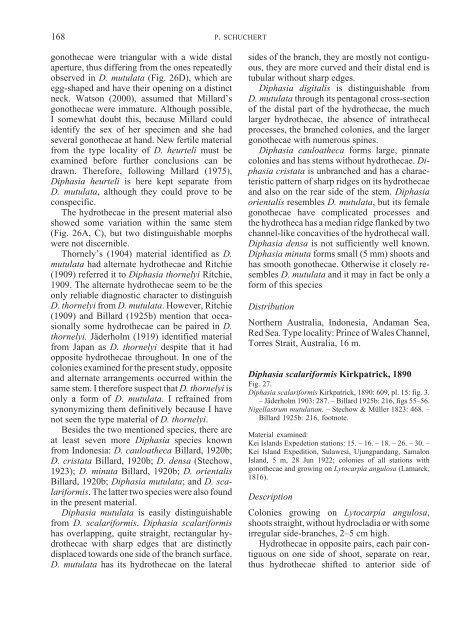Hydroids (Cnidaria, Hydrozoa) of the Danish expedition to
Hydroids (Cnidaria, Hydrozoa) of the Danish expedition to
Hydroids (Cnidaria, Hydrozoa) of the Danish expedition to
You also want an ePaper? Increase the reach of your titles
YUMPU automatically turns print PDFs into web optimized ePapers that Google loves.
168<br />
gono<strong>the</strong>cae were triangular with a wide distal<br />
aperture, thus differing from <strong>the</strong> ones repeatedly<br />
observed in D. mutulata (Fig. 26D), which are<br />
egg-shaped and have <strong>the</strong>ir opening on a distinct<br />
neck. Watson (2000), assumed that Millard’s<br />
gono<strong>the</strong>cae were immature. Although possible,<br />
I somewhat doubt this, because Millard could<br />
identify <strong>the</strong> sex <strong>of</strong> her specimen and she had<br />
several gono<strong>the</strong>cae at hand. New fertile material<br />
from <strong>the</strong> type locality <strong>of</strong> D. heurteli must be<br />
examined before fur<strong>the</strong>r conclusions can be<br />
drawn. Therefore, following Millard (1975),<br />
Diphasia heurteli is here kept separate from<br />
D. mutulata, although <strong>the</strong>y could prove <strong>to</strong> be<br />
conspecific.<br />
The hydro<strong>the</strong>cae in <strong>the</strong> present material also<br />
showed some variation within <strong>the</strong> same stem<br />
(Fig. 26A, C), but two distinguishable morphs<br />
were not discernible.<br />
Thornely’s (1904) material identified as D.<br />
mutulata had alternate hydro<strong>the</strong>cae and Ritchie<br />
(1909) referred it <strong>to</strong> Diphasia thornelyi Ritchie,<br />
1909. The alternate hydro<strong>the</strong>cae seem <strong>to</strong> be <strong>the</strong><br />
only reliable diagnostic character <strong>to</strong> distinguish<br />
D. thornelyi from D. mutulata. However, Ritchie<br />
(1909) and Billard (1925b) mention that occasionally<br />
some hydro<strong>the</strong>cae can be paired in D.<br />
thornelyi. Jäderholm (1919) identified material<br />
from Japan as D. thornelyi despite that it had<br />
opposite hydro<strong>the</strong>cae throughout. In one <strong>of</strong> <strong>the</strong><br />
colonies examined for <strong>the</strong> present study, opposite<br />
and alternate arrangements occurred within <strong>the</strong><br />
same stem. I <strong>the</strong>refore suspect that D. thornelyi is<br />
only a form <strong>of</strong> D. mutulata. I refrained from<br />
synonymizing <strong>the</strong>m definitively because I have<br />
not seen <strong>the</strong> type material <strong>of</strong> D. thornelyi.<br />
Besides <strong>the</strong> two mentioned species, <strong>the</strong>re are<br />
at least seven more Diphasia species known<br />
from Indonesia: D. cauloa<strong>the</strong>ca Billard, 1920b;<br />
D. cristata Billard, 1920b; D. densa (Stechow,<br />
1923); D. minuta Billard, 1920b; D. orientalis<br />
Billard, 1920b; Diphasia mutulata; and D. scalariformis.<br />
The latter two species were also found<br />
in <strong>the</strong> present material.<br />
Diphasia mutulata is easily distinguishable<br />
from D. scalariformis. Diphasia scalariformis<br />
has overlapping, quite straight, rectangular hydro<strong>the</strong>cae<br />
with sharp edges that are distinctly<br />
displaced <strong>to</strong>wards one side <strong>of</strong> <strong>the</strong> branch surface.<br />
D. mutulata has its hydro<strong>the</strong>cae on <strong>the</strong> lateral<br />
P. SCHUCHERT<br />
sides <strong>of</strong> <strong>the</strong> branch, <strong>the</strong>y are mostly not contiguous,<br />
<strong>the</strong>y are more curved and <strong>the</strong>ir distal end is<br />
tubular without sharp edges.<br />
Diphasia digitalis is distinguishable from<br />
D. mutulata through its pentagonal cross-section<br />
<strong>of</strong> <strong>the</strong> distal part <strong>of</strong> <strong>the</strong> hydro<strong>the</strong>cae, <strong>the</strong> much<br />
larger hydro<strong>the</strong>cae, <strong>the</strong> absence <strong>of</strong> intra<strong>the</strong>cal<br />
processes, <strong>the</strong> branched colonies, and <strong>the</strong> larger<br />
gono<strong>the</strong>cae with numerous spines.<br />
Diphasia cauloa<strong>the</strong>ca forms large, pinnate<br />
colonies and has stems without hydro<strong>the</strong>cae. Diphasia<br />
cristata is unbranched and has a characteristic<br />
pattern <strong>of</strong> sharp ridges on its hydro<strong>the</strong>cae<br />
and also on <strong>the</strong> rear side <strong>of</strong> <strong>the</strong> stem. Diphasia<br />
orientalis resembles D. mutulata, but its female<br />
gono<strong>the</strong>cae have complicated processes and<br />
<strong>the</strong> hydro<strong>the</strong>ca has a median ridge flanked by two<br />
channel-like concavities <strong>of</strong> <strong>the</strong> hydro<strong>the</strong>cal wall.<br />
Diphasia densa is not sufficiently well known.<br />
Diphasia minuta forms small (5 mm) shoots and<br />
has smooth gono<strong>the</strong>cae. O<strong>the</strong>rwise it closely resembles<br />
D. mutulata and it may in fact be only a<br />
form <strong>of</strong> this species<br />
Distribution<br />
Nor<strong>the</strong>rn Australia, Indonesia, Andaman Sea,<br />
Red Sea. Type locality: Prince <strong>of</strong> Wales Channel,<br />
Torres Strait, Australia, 16 m.<br />
Diphasia scalariformis Kirkpatrick, 1890<br />
Fig. 27.<br />
Diphasia scalariformis Kirkpatrick, 1890: 609, pl. 15: fig. 3.<br />
– Jäderholm 1903: 287. – Billard 1925b: 216, figs 55–56.<br />
Nigellastrum mutulatum. – Stechow & Müller 1823: 468. –<br />
Billard 1925b: 216, footnote.<br />
Material examined:<br />
Kei Islands Expedetion stations: 15. – 16. – 18. – 26. – 30. –<br />
Kei Island Expedition, Sulawesi, Ujungpandang, Samalon<br />
Island, 5 m, 28 Jun 1922; colonies <strong>of</strong> all stations with<br />
gono<strong>the</strong>cae and growing on Ly<strong>to</strong>carpia angulosa (Lamarck,<br />
1816).<br />
Description<br />
Colonies growing on Ly<strong>to</strong>carpia angulosa,<br />
shoots straight, without hydrocladia or with some<br />
irregular side-branches, 2–5 cm high.<br />
Hydro<strong>the</strong>cae in opposite pairs, each pair contiguous<br />
on one side <strong>of</strong> shoot, separate on rear,<br />
thus hydro<strong>the</strong>cae shifted <strong>to</strong> anterior side <strong>of</strong>

















